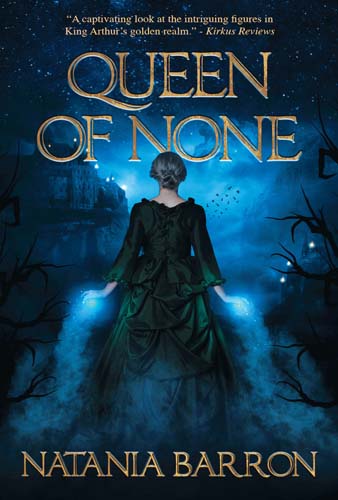Natania Barron tells me just how accurate Monty Python and the Holy Grail is and how it relates to her latest book, Queen of None. It surprised me.

The first time I became aware of Monty Python and the Holy Grail, it was because my parents were trying to explain it to me. They were both giggling so hard just trying to get the words out. I might have been thirteen or so, and I was pretty well convinced they’d lost their marbles. They kept talking about bloodthirsty rabbits. Which, quite frankly, didn’t seem very funny to me at all.
I didn’t quite grasp the humor until I finally saw the whole film later in high school. Then it became very much a thing. My nerd friends and I, as the eldest of the millennials, found the entire script of Monty Python and the Holy Grail on a BB somewhere, printed it out, and carried it around to every class. We began spouting quotes, particularly, “Very small rocks,” “I feel happy!” and “Help, help, I’m being repressed!” much to the sincere annoyance of just about everyone else.
It wasn’t until college, however, when I was deep into my own study of the Middle Ages, that I learned just how good this movie really was. And not just because of the humor. It turns out that Monty Python and the Holy Grail is weirdly, bizarrely, wonderfully… historically accurate in a number of ways.
Okay, but how?
Terry Jones is how. The late writer, actor, and comedian was also a seasoned medievalist. You might be familiar with his Medieval Lives series, from the BBC, but he was known as quite the scholar even outside of the glamor of film. His enthusiasm, humor, and joy had everything to do with what made Holy Grail so good.
And those rabbits? Totally historically accurate. There’s a really good overview about evil rabbits here from Jon Kaneko-James that will do it more justice than I can, but let’s just say that murderous, blood-thirsty rabbits are a very prolific theme in the Middle Ages. I studied illuminated manuscripts at length during my college days, and I found numerous examples. Now, with digital age in full swing, you can peruse thousands of manuscripts and do your own Where’s Waldo: Evil Rabbit Edition.
So, don’t even get me started on butt trumpets. Yes, butt trumpets. And snail men. And furious archer monkeys. Not to mention cats getting into everything some of the most beautiful, strange, and creative chimera monsters you’ll ever see (my favorites are from the Luttrell Psalter—which doesn’t just include monsters, but also depictions of daily life in beautiful, humorous detail). We may think that Terry Gilliam just sort of procured the images from his very original brain, but so much of the animation in the film is also directly adapted from illuminated manuscripts.
Perhaps that’s what’s always brought me back to the Medieval Period again and again. I never believed in a “Dark” age, really. Yes, of course, there were all kinds of very nasty things that happened in the period, from oppression to plague, from Church domination to war, from class exploitation to famine. It wasn’t an easy time to be a human being. But, regardless of the trials and tribulations, what illuminated manuscripts show us is a glimpse into the medieval mind, a mind capable of critique, humor, nuance, and vivid, technicolor imagination. Maybe we aren’t so different. Perhaps what makes existence tolerable now is what made it tolerable then.
It’s also the same reason that I haven’t given up on my studies. You’ll not just find my studies in medieval literature and history influence my work, but also my Twitter account. I’m a big fan of delving deep to find strange marginalia to share with my audience. Sometimes, they’re a little traumatized. Other times, they’re just thoroughly amused. We have a great deal more in common with people in the Middle Ages than we don’t, and it’s important that we learn from them.
--
Natania Barron has been traveling to other worlds from a very young age, and will be forever indebted to Lucy Pevensie and Meg Murry for inspiring her to go on her own adventures. She currently resides in North Carolina with her family, and is, at heart, a hobbit–albeit it one with a Tookish streak a mile wide. Be sure to check out Queen of None.